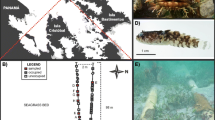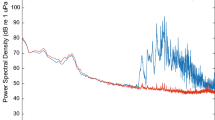Abstract
The use of sound in social interactions has been documented in several species of sculpin and may be used to convey information concerning species identity, intent, or fitness. Sound production may be a particularly important mode of communication in sculpin due to their nocturnal behavior and construction of nests in rock cavities where the efficacy of visual cues may be diminished. In this study, we describe acoustic signals produced during conspecific behavioral interactions in Cottus carolinae, and compare signal characteristics to the only other known sounds producers in the genus Cottus including C. gobio, C. rhenanus, C. perifretum, C. bairdii, and C. paulus. Sounds were produced during nocturnal encounters between cavity residents and intruders, and consisted of pulsatile signals that were arranged into pulse trains with remarkably long pulse intervals of approximately 1 s, as well as tonal sounds in which the periodicity was increased to approximately 60 Hz. We found no relationship between fish standard length and pulse instantaneous frequency or total pulse train duration, but did find a positive correlation between fish standard length and pulse duration, as well as position of pulse interval within the pulse train. We found that C. carolinae pulse train structure differed significantly from that of other published sculpin species, and that C. carolinae produce tonal sounds; a characteristic unique within the genus Cottus.







Similar content being viewed by others
References
Akamatsu T, Okumura T, Novarini N, Yan HY (2002) Empirical refinements applicable to the recording of fish sounds in small tanks. J Acoust Soc Am 112:3073–3079
Amorim MCP (2006) Diversity of sound production in fish. In: Ladich F, Collin SP, Moller P, Kapoor BG (eds) Communication in fishes. Springer-Verlag, Wien, pp 1–33
Amorim MCP, McCracken ML, Fine ML (2002) Metabolic costs of sound production in the oyster toadfish, Opsanus tau. Can J Zool 80(5):830–838
Amorim MCP, Simões JM, Fonseca PJ, Turner GF (2008) Species differences in courtship acoustic signals among five Lake Malawi cichlid species (Pseudotropheus spp.). J Fish Biol 72(6):1355–1368
Amorim MCP, Simões JM, Mendonça N, Bandarra NM, Almada VC, Fonseca PJ (2010) Lusitanian toadfish song reflects male quality. J Exp Biol 213:2997–3004
Barber SB, Mowbray WH (1956) Mechanism of sound production in the sculpin. Science 124(3214):219–220
Boschung HT, Mayden RL (2004) Fishes of Alabama. The Smithsonian Institute, Washington, DC
Bradbury J. W, Vehrencamp S. L (1998) Principles of animal communication. Sinauer, Massachusetts pp 279–315
Casaretto L, Hawkins AD (2002) Spawning behaviour and the acoustic repertoire of haddock. Bioacoustics 12:250–252
Colleye O, Ovidio M, Salmon A, Parmentier E (2013) Contribution to the study of acoustic communication in two Belgian river bullheads (Cottus rhenanus and C. perifretum) with further insight into the sound-producing mechanism. Front Zool 10:71
Connaughton MA, Taylor MH, Fine ML (2000) Effects of fish size and temperature on weakfish disturbance calls: implications for the mechanism of sound generation. J Exp Biol 203(9):1503–1512
Craddock JE (1965) Some aspects of the life history of the banded sculpin, Cottus carolinae carolinae, in Doe Run, Meade County, Kentucky. Dissertation, University of Louisville
Crawford JD, Cook AP, Heberlein AS (1997) Bioacoustic behavior of African fishes (Mormyridae): potential cues for species and individual recognition in Pollimyrus. J Acoust Soc Amer 102:1200–1212
Cruz A, Lombarte A (2004) Otolith size and its relationship with colour patterns and sound production. J Fish Biol 65(6):1512–1525
Downhower JF, Brown L (1980) Mate preferences of female mottled sculpins, Cottus bairdi. Anim Behav 28(3):728–734
dos Santos M, Modesto T, Matos RJ, Grober MS, Oliveira RF, Canario A (2000) Sound production by the Lusitanian toadfish, Halobatrachus didactylus. Bioacoustics 10:309–321
Edds-Walton PL, Mangiamele LA, Rome LC (2002) Variations of pulse repetition rate in boatwhistle sounds from oyster toadfish Opsanus tau around Waquoit Bay, Massachusetts. Bioacoustics 13(2):153–173
Fine ML (1978) Seasonal and geographical variation of the mating call of the oyster toadfish Opsanus tau L. Oecologia 36(1):45–57
Fine ML, Burns NM, Harris TM (1990) Ontogeny and sexual dimorphism of sonic muscle in the oyster toadfish. Can J Zool 68(7):1374–1381
Fine ML, Ladich F (2003) Sound production, spine locking and related adaptations. Catfishes 1:249–290
Fine ML, Waybright TD (2015) Grunt variation in the oyster toadfish Opsanus tau: effect of size and sex. PeerJ 3:e1330. https://doi.org/10.7717/peerj.1330
Forrest TG, Miller GL, Zagar JR (1993) Sound propagation in shallow water: implications for acoustic communication by aquatic animals. Bioacoustics 4(4):259–270
Gebhard AE, Perkin JS (2017) Assessing riverscape-scale variation in fish life history using banded sculpin (Cottus carolinae). Environ Biol Fish 100(11):1397–1410
Goto A (1993) Male mating success and female mate choice in the river sculpin, Cottus nozawae (Cottidae). Environ Biol Fish 37(4):347–353
Hallacher LE (1974) The comparative morphology of extrinsic gasbladder musculature in the scorpionfish genus Sebastes (Pisces: Scorpaenidae). Proc Calif Acad Sci 40:59–86
Herman LM, Tavolga WN (1980) The communication systems of cetaceans. In: Herman LM (ed) Cetacean Behavior: Mechanisms and Functions. Wiley, New York, pp 149–210
Hill GL, Fine ML, Musick JA (1987) Ontogeny of the sexually dimorphic sonic muscle in three sciaenid species. Copeia:708–713
Kasumyan AO (2008) Sounds and sound production in fishes. J Ichthyol 48(11):981–1030
Kierl N. C (2009) The Roles of Acoustic and Visual Signals in the Reproductive Behavior of the Federally Threatened Pygmy Sculpin, Cottus paulus, (Cottidae). Masters Thesis, Auburn University
Kierl NC, Johnston CE (2010) Sound production in the pygmy sculpin Cottus paulus (Cottidae) during courtship and agonistic behaviours. J Fish Biol 77:1268–1281
Kihslinger RL, Klimley AP (2002) Species identity and the temporal characteristics of fish acoustic signals. J Comp Psychol 116:210
Kinziger AP, Wood RM, Neely DA (2005) Molecular systematics of the genus Cottus (Scorpaeniformes: Cottidae). Copeia 2005(2):303–311
Kratochvil H (1978) Der bau des lautapparates vom knurrenden gurami (Trichopsis vittatus Cuvier & Valenciennes)(Anabantidae, Belontiidae). Zoomorphologie 91(1):91–99
Ladich F (1989) Sound production by the river bullhead, Cottus gobio L. (Cottidae, Teleostei). J Fish Biol 35:531–538
Ladich F (2017) Acoustic communication in fishes: temperature plays a role. Fish Fish 19:598–612
Ladich F, Fine ML (2006) Sound-generating mechanisms in fishes: a unique diversity in vertebrates. Communication in fishes 1:3–43
Lugli M, Pavan G, Torricelli P (2004) The response of the male freshwater goby to natural and synthetic male courtship sound playback following exposure to different female sexual stimuli. Ethol Ecol Evol 16(1):55–70
May-Collado LJ, Agnarsson I, Wartzok D (2007) Phylogenetic review of tonal sound production in whales in relation to sociality. BMC Evol Biol 7:136
Mitchell S, Poland J, Fine ML (2008) Does muscle fatigue limit advertisement calling in the oyster toadfish Opsanus tau? Anim Behav 76(3):1011–1016
Morris D (1954) The reproductive behaviour of the river bullhead (Cottus gobio L.), with special reference to the fanning activity. Behaviour:1–32
NatureServe (2013) The IUCN Red List of Threatened Species 2013. https://www.iucnredlist.org/species/202652/15361487. Accessed 04 December 2019
Page LM, Burr BM (2011) Peterson field guide to freshwater fishes of North America north of Mexico, 2nd edn. Houghton Mifflin Harcourt, New York
Papes S, Ladich F (2011) Effects of temperature on sound production and auditory abilities in the striped Raphael catfish Platydoras armatulus (family Doradidae). PLoS One 6(10):e26479
Phillips E, Kilambi RV (1996) Food habits of four benthic fish species (Etheostoma spectabile, Percina caprodes, Noturus exilis, Cottus carolinae) from Northwest Arkansas streams. Southwest Nat 41(1):69–73
Rountree R. A, Goudey C. A, Hawkins A. D, Luczkovich J. J, Mann D. A (2003) Listening to fish: passive acoustic applications in marine fisheries. Sea Grant digital oceans, Massachusetts Institute of Technology sea Grant College program, special report MITSG 03–01, Cambridge
Savage T (1963) Reproductive behavior of the mottled sculpin, Cottus bairdi Girard. Copeia 1963:317–325
Schaller F, Kratochvil H (1981) Lautbildung bei Fischen. Biol Unserer Zeit 11(2):43–47
Thorson RF, Fine ML (2002) Crepuscular changes in emission rate and parameters of the boat whistle advertisement call of the gulf toadfish, Opsanus beta. Environ Biol Fish 63:321–331
U.S. Geological Survey (2016) National Water Information System data available on the world wide web. USGS Water Data for the Nation. http://waterdata.usgs.gov/nwis/. Accessed 23 October 2019
Weston DE (1967) Sound propagation in the presence of bladder fish. In: Albers VM (ed) Underwater acoustics. Plenum, New York, pp 55–88
Whang A, Janssen J (1994) Sound production through the substrate during reproduction in the mottled sculpin, Cottus bairdi (Cottidae). Environ Biol Fish 40:141–148
Wilson B, Batty RS, Dill LM (2004) Pacific and Atlantic herring produce burst pulse sounds. Proc R Soc Lond B (Suppl) 271:S95–S97
Zeyl JN, Malavasi S, Holt DE, Noel P, Lugli M, Johnston CE (2016) Convergent aspects of acoustic communication in darters, Sculpins, and gobies. In: Sisneros JA (ed) Fish hearing and bioacoustics. Springer, Cham, pp 93–120
Acknowledgements
We would like to thank Jenna Crovo, Heath Haley, Jeff Zeyl, and the many other members of the lab who assisted with collection and care of animals throughout this project.
Author information
Authors and Affiliations
Corresponding author
Ethics declarations
Conflict of interest
The authors declare that they have no conflict of interest.
Ethical approval
All applicable international, national, and/or institutional guidelines for the care and use of animals were followed. All procedures performed were in accordance with the ethical standards of Auburn University (Institutional Animal Care and Use Committee, Permit number 2017–3126).
Additional information
Publisher’s note
Springer Nature remains neutral with regard to jurisdictional claims in published maps and institutional affiliations.
Rights and permissions
About this article
Cite this article
Holt, D.E., Friebertshauser, R.J. & Johnston, C.E. Sound production of the banded Sculpin, Cottus carolinae. Environ Biol Fish 103, 299–311 (2020). https://doi.org/10.1007/s10641-020-00964-x
Received:
Accepted:
Published:
Issue Date:
DOI: https://doi.org/10.1007/s10641-020-00964-x




